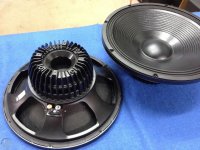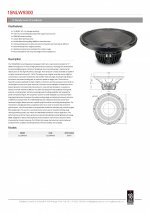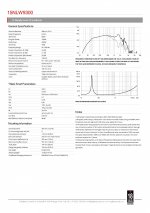Ro808, what would be the efficiency of Eminence Deltalite II 2515 or Acoustic Elegance TD15M ?
Eminence Deltalite II 2515: 3.584%
Reference power calculated at ± 30% for an Xmax of ± 4.80 mm = 201 Watts. (141 to 287 Watts)
Acoustic Elegance TD15M: 3.621%
Reference power calculated at ± 30% for an Xmax of ± 6.00 mm = 192 Watts. (135 to 275 Watts)
It definitely is.
Previously in this thread references were posted of people who have owned/built and/or extensively listened to heavy coned loudspeaker systems. These people were pleasantly surprised - to use an understatement - by listening to similar sized loudspeakers with a lighter cone (as well as a bigger compression driver and 'a faulty' horn).
Previously in this thread references were posted of people who have owned/built and/or extensively listened to heavy coned loudspeaker systems. These people were pleasantly surprised - to use an understatement - by listening to similar sized loudspeakers with a lighter cone (as well as a bigger compression driver and 'a faulty' horn).
Last edited:
ELECTROVOICE DL15X: 4.682% (η₀)
Reference power calculated at ± 30% for an Xmax of ± 4.10 mm = 209 Watts. (146 to 299 Watts)
Reference power calculated at ± 30% for an Xmax of ± 4.10 mm = 209 Watts. (146 to 299 Watts)
Attachments
-
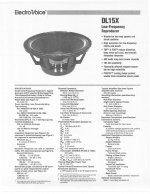 electro_voice_dl15x_spec_Pagina_1.jpg211.7 KB · Views: 318
electro_voice_dl15x_spec_Pagina_1.jpg211.7 KB · Views: 318 -
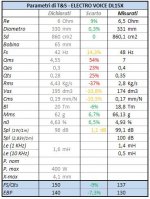 electro-voice_dl15x_par.jpg55.8 KB · Views: 63
electro-voice_dl15x_par.jpg55.8 KB · Views: 63 -
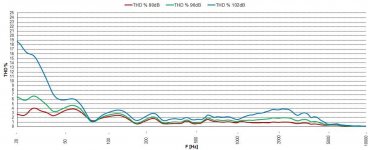 electro-voice_dl15x_thd.jpg81.1 KB · Views: 58
electro-voice_dl15x_thd.jpg81.1 KB · Views: 58 -
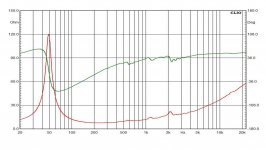 electro-voice_dl15x_imp.jpg81.5 KB · Views: 71
electro-voice_dl15x_imp.jpg81.5 KB · Views: 71 -
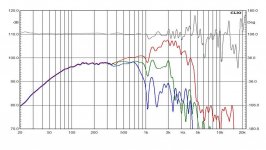 electro-voice_dl15x_risp.jpg98.1 KB · Views: 307
electro-voice_dl15x_risp.jpg98.1 KB · Views: 307 -
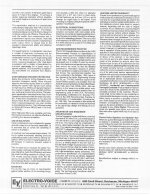 electro_voice_dl15x_spec_Pagina_4.jpg426.8 KB · Views: 300
electro_voice_dl15x_spec_Pagina_4.jpg426.8 KB · Views: 300 -
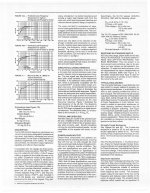 electro_voice_dl15x_spec_Pagina_3.jpg335 KB · Views: 304
electro_voice_dl15x_spec_Pagina_3.jpg335 KB · Views: 304 -
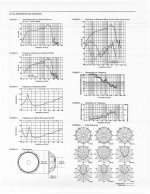 electro_voice_dl15x_spec_Pagina_2.jpg218.4 KB · Views: 321
electro_voice_dl15x_spec_Pagina_2.jpg218.4 KB · Views: 321
You guys better not run Geddes out of my thread, how about those beans ����*♂️����*♂️��
Right and wrong sure, the future belongs to the young, sure, wisdom is obtained by time and effort and if another person has that, in spades, it deserves respect, so give it. Theres a right and a wrong way to express a difference in opinion, get it right please.
Right and wrong sure, the future belongs to the young, sure, wisdom is obtained by time and effort and if another person has that, in spades, it deserves respect, so give it. Theres a right and a wrong way to express a difference in opinion, get it right please.
There's no right or wrong in the topic(s) under discussion, only approaches, experiences, opinions, philosophies (science), practices, preferences etc.
Some members of this forum swear by hornloaded midbass, a concept with its own set of requirements, advantages and disadvantages.
It's impossible to argue it's always the best, or worst solution.
Some members of this forum swear by hornloaded midbass, a concept with its own set of requirements, advantages and disadvantages.
It's impossible to argue it's always the best, or worst solution.
Last edited:
Having previous only used spherical shaped horns in the past for many years (Azurahorn JMLC, Goto unit horns, Auto-tech e-JMLC), been running the Faital Pro HF108R paired with PRV WG35-25-b 'waveguide' for past few days. Very good pairing (good balance of detail/refinement/extension) and no obvious downfalls I can hear so far from a non-spherical design. The HF108R does have a more 'delicate' sound compared to the HF107 units. Certainly a more suitable choice for domestic/near-field use.
Really impressed with Faital Pro products so far!
Really impressed with Faital Pro products so far!
The HF108R does have a more 'delicate' sound compared to the HF107 units. Certainly a more suitable choice for domestic/near-field use.!
One explanation for the difference you describe may be the Combined Exit of the HF107 (the driver's exit coincides with the end of the phase plug, there is no adaptation throat), versus the 31° exit of the HF108R.
Last edited:
Yes indeed. I'm using a Marchand XM9 24db slope electronic unit at the moment. 1khz xo point (fixed by resistors so not easily adjustable).
Still need time to get my Najda DSP XO unit boxed up and use that instead. Will give me faster ability to play with xo points/slopes.
15PR400 is sealed cab. Boosted low freq with lots of EQ. Most likely will go ported when figured out how to do it properly.
Still contemplating adding 2nd pair of 15PR400 so will become MTM config. Price is right for 15PR400 units from faital seller in Aus.
Subjectively, SQ from 15PR400 playing upto 1khz is acceptable (I'm used to front horn loaded mid-bass - but can no longer do due to room restrictions). Improved clarity over Beyma 15G40 units.
Still need time to get my Najda DSP XO unit boxed up and use that instead. Will give me faster ability to play with xo points/slopes.
15PR400 is sealed cab. Boosted low freq with lots of EQ. Most likely will go ported when figured out how to do it properly.
Still contemplating adding 2nd pair of 15PR400 so will become MTM config. Price is right for 15PR400 units from faital seller in Aus.
Subjectively, SQ from 15PR400 playing upto 1khz is acceptable (I'm used to front horn loaded mid-bass - but can no longer do due to room restrictions). Improved clarity over Beyma 15G40 units.
Last edited:
But isn't my way the right way ??????????
Lol, just kidding everyone.
Question of the day: There's the right way, the wrong way and the Army way, but who's the Army?
GM
One explanation for the difference you describe may be the Combined Exit of the HF107 (the driver's exit coincides with the end of the phase plug, there is no adaptation throat), versus the 31° exit of the HF108R.
May it be something to do with the following too?
Test Bench: Faital Pro HF108R Compression Driver | audioXpress
Compared to the HF108 compression driver, the HF108R incorporates a more rigid clamping system on the diaphragm. This creates a more subtle listening experience when the distance between the enclosure and the target audience is limited (as in a bar / club / restaurant or for a home listening situation) since it is typical for the compression drivers to be somewhat overwhelming when listened to in the near field. This requires additional machining in the gap as well as the alternative clamping method.
...
The HR108R is a solid performer. I think it’s great that Faital Pro crafted a compression driver specifically intended for close monitoring situations.
There are cone issues? starting at 300Hz which are not apparent in 15BG100...
I quote my own post as it probably got lost in the x fire�� And I mean FP 400 issues for clarification as it disappeared in the quote
Last edited:
I quote my own post as it probably got lost in the crossfire��
I do not know who did rhe measurement, but either faital nor troel gravesen found cone issues:
OBL-15
He wrote:
————
The Faital 15PR-400 is an extraordinary linear driver! This driver goes flat up to 4 kHz; a 15" driver!
————
I could confirm this too!
Last edited:
May it be something to do with the following too?
Test Bench: Faital Pro HF108R Compression Driver | audioXpress
Compared to the HF108 compression driver, the HF108R incorporates a more rigid clamping system on the diaphragm. This creates a more subtle listening experience when the distance between the enclosure and the target audience is limited (as in a bar / club / restaurant or for a home listening situation) since it is typical for the compression drivers to be somewhat overwhelming when listened to in the near field. This requires additional machining in the gap as well as the alternative clamping method.
...
The HR108R is a solid performer. I think it’s great that Faital Pro crafted a compression driver specifically intended for close monitoring situations.
Yes, that's a contributing factor as well.
The diaphragms of the HF108 and HF108R are not interchangeable.
This combined with the different throat section (compared to the HF107) does affect the response and the perceived soundquality.
Did you also try the HF107 with the PRV horn?
There are cone issues? starting at 300Hz which are not apparent in 15BG100...
You refer to the ripple in the combined response, I guess ?
This is either cone/surround related, but it doesn't affect distortion figures, which are actually lower compared to the B&C 15BG100 in this region.
The ripple dissapears above 700/800Hz.
If you look at the plots of the 18Sound 15W700 posted on the same page, you'll notice it's exceptionally clean in this region, but the Faital beats it wrt distortion figures both in the lower as well in the upper part of the freq. range.
With respect to the discussion earlier about heavy vs. light cones, it's interesting to quote Holger Barske, one of German's prominent (diy)audio gurus, in the review of the Unison Research Max-2 (regarding the 18 Sound 15NLW9300):
"In the MAX-2, a woofer from the Italian specialist Eighteensound is used. Drivers of this manufacturer also fuel the MAX-1.
In fact, the fifteen is a close relative of the twelve inch from the MAX-1 and has the same, but for this application completely over the top specifications: a nominal load capacity of 800 watts is not needed here - the driver is consistently designed with "indestructibility" in mind.
The PA professional likes a maximum stroke of 37 Millimeters, but we need neither the full four-inch voice coil, nor the moving mass of well over
100 grams. Such a driver would not have been my first choice for this project."

Attachments
Last edited:
15PR400 is sealed cab. Boosted low freq with lots of EQ. Most likely will go ported when figured out how to do it properly.
Still contemplating adding 2nd pair of 15PR400 so will become MTM config. Price is right for 15PR400 units from faital seller in Aus.
.
a 2nd pair? How big is your lounge tuyen?
It's quite funny to realize the Max-2 has been developed with tube amplifier use in mind. As apparent from several reviews it only starts to 'open up' with a decent powerhouse connected to the terminals.
Despite its delicate looks, it's actually well suited for fullrange duties in a small to medium sized club.
The objectives are clearly stated in the specsheet:
"The design has evolved from an extensive R&D program carried out at Eighteen Sound, providing clean, undistorted LF reproduction at very high SPL without damages. The transducer is mainly intended as woofer in compact vented enclosures (65 - 130 lit). The external neo magnet assembly assures high flux concentration, low power compression and excellent heat exchange, resulting in high levels of force factor and power handling with an optimum power to weight ratio...
The suspension system has been designed to provide symmetric large signal behaviour throughout the whole working range, providing low harmonic distortion at different excitation levels...
The result is a very linear piston action across the entire working range reducing breaking modes, and makes the 15NLW9300 suitable for outdoor application."
Despite its delicate looks, it's actually well suited for fullrange duties in a small to medium sized club.
The objectives are clearly stated in the specsheet:
"The design has evolved from an extensive R&D program carried out at Eighteen Sound, providing clean, undistorted LF reproduction at very high SPL without damages. The transducer is mainly intended as woofer in compact vented enclosures (65 - 130 lit). The external neo magnet assembly assures high flux concentration, low power compression and excellent heat exchange, resulting in high levels of force factor and power handling with an optimum power to weight ratio...
The suspension system has been designed to provide symmetric large signal behaviour throughout the whole working range, providing low harmonic distortion at different excitation levels...
The result is a very linear piston action across the entire working range reducing breaking modes, and makes the 15NLW9300 suitable for outdoor application."
Last edited:
Just as a sidenote: The Max 2 pictured above is an older variant, the newer ones have an LTH142 waveguide. I guess it is because it looks prettier ……
Holger Barske is also a member of this forum BTW.
When I have time to spare I will mount my 15nlw9500 in my MTM cabs instead of the Beyma 15lx60v2 just out of curiosity. The cone and especially the surround of the 15nlw9500 are probably less suited for two ways compared to the 15lx but it has a much lower Le.
Regards
Charles
Holger Barske is also a member of this forum BTW.
When I have time to spare I will mount my 15nlw9500 in my MTM cabs instead of the Beyma 15lx60v2 just out of curiosity. The cone and especially the surround of the 15nlw9500 are probably less suited for two ways compared to the 15lx but it has a much lower Le.
Regards
Charles
Last edited:
- Home
- Loudspeakers
- Multi-Way
- Is it possible to cover the whole spectrum, high SPL, low distortion with a 2-way?

